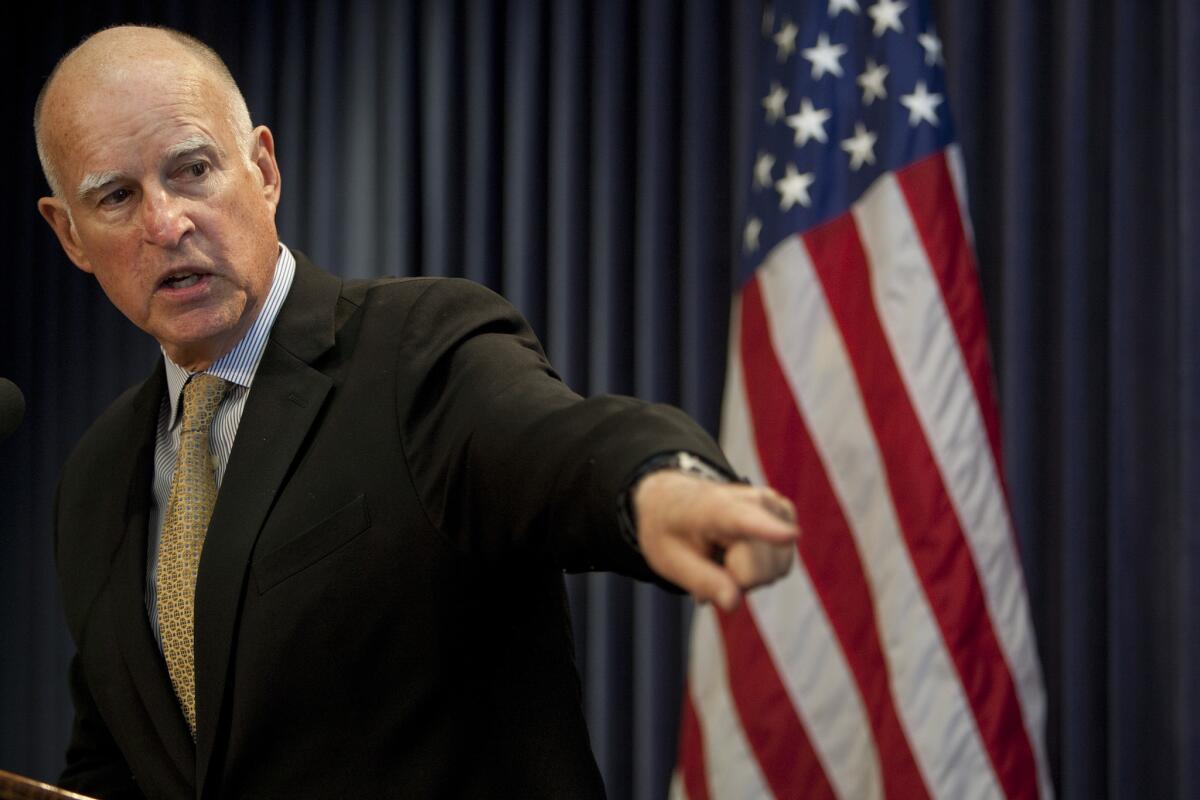Gov. Jerry Brown resists unzipping school construction wallet

- Share via
Reporting From SACRAMENTO — Who can be against building, modernizing or repairing schools? It’s good for children and creates jobs.
It improves learning and stimulates the economy.
It’s like motherhood and apple pie. Who dares dump on that?
Well, behind closed doors in the Capitol, a debt-dumping governor, for one.
There’s a school construction bond bill that has sailed through the Assembly and five committees with 122 “yes” votes — Democrat and Republican — and not a single “no.” But its chances of passing the Senate and making it to the November state ballot seem slim.
Although Gov. Jerry Brown has taken no position publicly, he has strongly signaled his resistance privately.
And that’s being reflected among the Democratic Senate leadership.
Senate President Pro Tem Darrell Steinberg (D-Sacramento) is focused on trying to negotiate a water bond, regarding that as a much higher political and policy priority.
Steinberg is termed out this year and feels personally responsible for crafting a new water bond. He negotiated the last one in 2009, a pork-laden, $11.1-billion stinker that has twice been pulled off the ballot for fear of voter revulsion.
Brown — casting himself as a debt-fighting fiscal conservative — never wanted even a water bond on the ballot as he ran for reelection to a fourth term. But the drought has forced him to accept at least a smaller version of what the Legislature had been proposing.
Senate Democrats were pushing $10.5 billion. Brown said he’d accept $6 billion. So figure on maybe $8 billion.
Let’s not forget, of course, that the taxpayers’ cost of a bond is actually twice the sticker price when you add in interest over 30 years.
The state’s outstanding general obligation bond debt is $76 billion, according to the governor’s office. That currently amounts to a $5.2-billion annual hit on the general fund. Plus, there’s $25 billion in bond borrowing that has been authorized but not used. Additionally, there’s a $27-billion “wall of debt” that includes money owed to local governments, schools and special funds.
So Brown isn’t exactly being a Don Quixote on this.
His resistance to accumulating more debt, however, does not extend to the bullet train bonds he’s trying to persuade a court to let him peddle.
The next Senate leader, Sen. Kevin de León (D-Los Angeles), seems to be following Steinberg’s lead. Neither apparently wants to push Brown further on bonds; they’ll be satisfied just to get an agreement on water.
Importantly, De León is chairman of the Senate Appropriations Committee, where the school bond bill has landed with a thud.
Whatever bond — water or school — passes the Legislature must win a two-thirds vote and secure the governor’s signature by mid-August in order to make it onto the November ballot.
One big political problem for the school bond is that there’s not a universal need. It’s spotty. Some big urban districts are losing enrollment and even shuttering schools. But kids are multiplying in outlying, less expensive areas.
According to the governor’s state Finance Department, overall enrollment in K-12 public schools is projected to grow less than 1% over the next 10 years. But there’ll be increasing numbers of students in the Inland Empire — Riverside and San Bernardino counties — and the southern San Joaquin Valley, especially Kern County. L.A. and Orange counties, meanwhile, will lose students, although many schools need modernization.
Here’s generally how school construction works: Districts talk local voters into passing bonds paid for by tax hikes. That money is matched by state bond funds. And developers kick in fees ultimately repaid by new home buyers.
If the state kitty is dry, developer fees increase to make up the difference, meaning higher home costs. And currently the state is about out of money.
Consequently, the developers’ lobby is pushing hard for a new state school bond.
Dave Cogdill, president of the California Building Industry Assn., and a former Senate Republican leader, says his group wanted a school bond two years ago. But it stood down at Brown’s request. The governor feared the bond proposal might hurt his chances of winning approval of his tax increase.
“So here we are with $3 billion in projects ready to go and the state’s out of money,” Cogdill says. “A bond bill moved through the Assembly without a hiccup. We’re telling the governor we’re willing to work with him, but not getting very far. And now we’re down to the end.”
Sacramento money for school construction is doled out by the state Allocation Board. Bill Savidge, the board’s assistant executive director, estimates the state is $12 billion short of what’s needed for new construction and modernization.
“Basically we’ve nothing left,” he says.
The bipartisan bond bill is co-sponsored by Assembly members Joan Buchanan (D-Alamo), chairman of the Education Committee, and Curt Hagman (R-Chino Hills).
“Every past governor — Republican and Democrat — has signed bills putting school bonds on the ballot,” Buchanan says. “Our problem right now is not in the Legislature. It’s convincing the governor there’s a need and this is an appropriate use of debt service.
“If you go back in history, you see that major infrastructure projects — for water, highways — have been paid by the users. But you can’t charge public school buildings to kids.”
The bond bill started out with a $9-billion price tag. That figure has been erased and the sponsors are waiting to hear from the governor. They’d be happy with half that amount. But Brown is ignoring them.
This governor’s not much of a multi-tasker. It’s a wonder how he got through school.
Follow @LATimesSkelton for more news on state government and politics.
More to Read
Sign up for Essential California
The most important California stories and recommendations in your inbox every morning.
You may occasionally receive promotional content from the Los Angeles Times.











